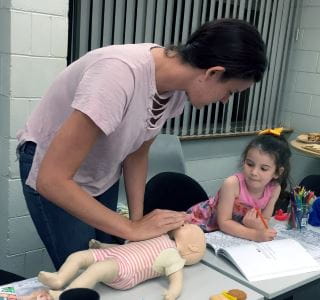Newman Community learn valuable lifesaving skills
Royal Life Saving Community Trainer, Robyn Taylor, was recently in Newman where she presented several education sessions. The sessions taught community members, from children through to adults, basic first aid skills and water safety knowledge.
The latest National Drowning Report shows that people in regional and remote areas of WA are almost four times more likely to drown than those in the Perth metropolitan area. WA’s Aboriginal children, aged 5-14 years, are 8.6 times more likely to die from drowning than non-Aboriginal children.
Royal Life Saving WA Senior Manager Swimming and Water Safety Education, Trent Hotchkin, says “the fact that people in regional and remote areas of our state are at such high risk of drowning is concerning. It highlights the need for improved access to appropriate first aid, lifesaving, swimming and water safety programs to ensure they have the knowledge and skills needed to participate safely in the unique aquatic environments that exist in these areas.”
The sessions included Water Safety Talks for school children at Newman Primary School and South Newman Primary. Also hosted was a Heart Beat Club which teaches parents and carers basic first aid and CPR response and a basic First Aid session with the children who attend the centre’s after school program. Many of these children have also previously participated in the Royal Life Saving WA Swim & Survive Access and Equity Program at Newman Aquatic.
This program in Newman is supported by Principal Community Partner BHP as part of their sponsorship of our Swim and Survive Access and Equity initiative.
Royal Life Saving WA is working hard to ensure people in regional and remote areas, and Aboriginal communities, are given the opportunity to learn vital lifesaving and first aid skills. Our Swim and Survive Access and Equity program is based on the belief that no child should miss out on vital swimming and water safety education no matter what their cultural background is, or where they live. It also aims to empower children and adults in at-risk communities to be the local first responders, especially in areas where access to paramedics and other professional medical response may be limited or delayed.
For more information on our training in First Aid, click below.
